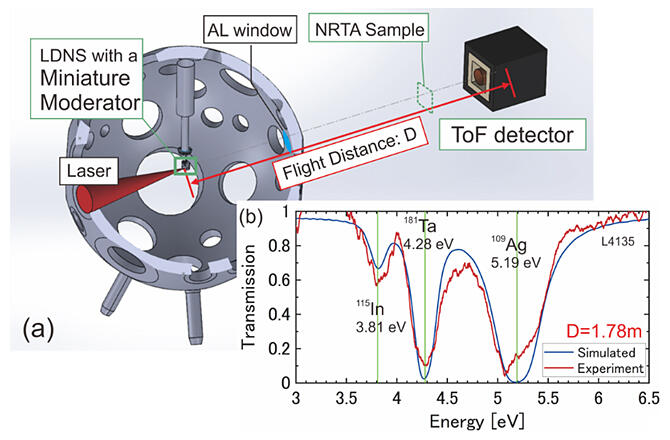A research group led by Professor Akifumi Yogo of the Institute of Laser Engineering at Osaka University, Senior Principal Researcher Takehito Hayakawa of the National Institutes for Quantum Science and Technology, manager Mitsuo Koizumi of the Japan Atomic Energy Agency, and Professor Hiroaki Nishimura of the Faculty of Engineering at Fukui University of Technology, has announced that they had discovered a law in the number of neutrons produced in proportion to the fourth power of the laser intensity that dramatically increases the number of neutrons. The researchers confirmed that 1011 neutrons can be produced in one laser shot based on this law. Non‐destructive measurements using neutron resonance absorption enabled them to measure the types and amounts of elements. As instantaneous irradiation is possible, they expect to expand their focus to include the inspection of substances and products that are in motion. The results are anticipated to lead to the realization of laboratory neutron irradiation tests without the need for accelerators or radioisotopes. The group's results were published in Physical Review X, published by the American Physical Society, on 31 January.

Provided by Professor Akifumi Yogo of the Institute of Laser Engineering at Osaka University
Neutrons are particles without a charge that make up the nucleus and react more readily and directly with incident matter than, for example, protons, which have an electric charge. Neutrons are produced and extracted from a neutron source and used for transmission measurements and elemental analysis using the properties of different reactions depending on the element. Sources of neutrons include nuclear reactors, accelerators and radioisotopes, but they are large‐scale, and radioisotopes are expensive and difficult to control.
Among these methods, there is a method of generating neutrons by focusing a high‐intensity laser on a material to accelerate protons and irradiate a specific material to generate neutrons through a nuclear reaction. The method is expected to be put into practical use as it can be realized on a smaller scale than conventional methods. It is known that increasing the intensity of the laser can produce a hotter plasma and increase the number of neutrons. However, it has been unclear how the laser intensity and the number of neutrons produced are determined, although it has been reported under various conditions.
In their study, the research group scrutinized the various conditions that had been reported so far, and also conducted experiments under various new conditions using the high‐power LFEX laser at the Institute of Laser Engineering at Osaka University.
Although the difference in experimental conditions is very small, they discovered a condition in which the number of neutrons generated differs by an order of magnitude. Experiments on this condition under various parameters revealed the existence of a 'fourth power law of laser intensity,' which dramatically increases the number of neutrons in proportion to the fourth power of the intensity. In addition, a theoretical model explaining this phenomenon was successfully developed.
Furthermore, based on the same principle, the researchers tested non‐destructive analysis of materials by neutron resonance absorption combined with time‐of‐flight measurement using high‐intensity neutron pulses (1011 neutrons). Specifically, they constructed an experimental system constructed to take advantage of the features of the laser neutron source to measure neutrons produced by the laser with a detector 1.8 meters away. Thin plates of indium, tantalum and silver were layered, and neutrons were transmitted through them to measure their energy. With conventional neutron sources, this analysis line would be tens of meters long.
As a result, they confirmed that peaks representing neutron absorption at energies corresponding to each of the three metals could be captured. The ability to separate the difference of a few eV in the peaks of each neighboring metal demonstrates that the laser neutron source is capable of elemental identification of unknown materials and their quantities.
Until now, for example, a single measurement took four to five hours on a 20‐meter beamline with an accelerator, but with a laser‐neutron source, not only can this be significantly reduced, but one measurement can be completed in 100 nanoseconds. This makes it possible to expand the scope of measurement to include devices that are in motion, and at the same time it is believed that the detection of nuclear vibrations makes it possible to measure the instantaneous temperature of the device. Neutrons do not carry an electrical charge, so they have little effect on things such as operating equipment and are expected to be used in product development.
"The laser we are currently using can only oscillate a few times a day, but we are working on changing the laser oscillation mechanism to semiconductors and transparent ceramics to build an experimental system with a much higher frequency," said Yogo. "We expect to have the first laser oscillations by the end of this year and to be able to develop a compact device in two to three years. If we can achieve this, we hope to be able to introduce the equipment in laboratories and in developing countries where nuclear reactors and other equipment could not previously be installed."
Journal Information
Publication: Physical Review X
Title: Laser‐Driven Neutron Generation Realizing Single‐Shot Resonance Spectroscopy
DOI: 10.1103/PhysRevX.13.011011
This article has been translated by JST with permission from The Science News Ltd. (https://sci-news.co.jp/). Unauthorized reproduction of the article and photographs is prohibited.




